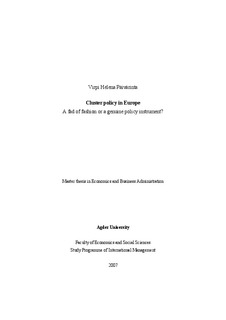| dc.contributor.author | Päivärinta, Virpi Helena | |
| dc.date.accessioned | 2008-06-18T12:09:53Z | |
| dc.date.issued | 2007 | |
| dc.identifier.uri | http://hdl.handle.net/11250/136400 | |
| dc.description | Masteroppgave i økonomi og administrasjon - Universitetet i Agder 2007 | en |
| dc.description.abstract | Clusters and clustering have become attractive policy measures, because they are leverage points
for action and innovations, not just descriptions of economic realities. Cluster policy is a field
where scientists meet the practice; many consultants, including academics, earn well by
specialising in cluster development. But what is the motivation behind cluster policies and
resources engaged in cluster development? This thesis presents an empirical study responding the
question: are cluster policies used to solve real problems in Europe or do they rather represent a
fad in fashion? An analysis framework, “the double-I model”, is developed based on previous
literature. It was used to analyse large-scale cluster policy information collected during Spring
2007 from European 20 countries. Through the double-I model, it was possible to find
differences between countries related to their implementation of cluster policies. The
instrumental and institutional approaches to cluster policy implementation seem to be almost
equally common in the European countries. | en |
| dc.format.extent | 973295 bytes | |
| dc.format.mimetype | application/pdf | |
| dc.language.iso | eng | en |
| dc.publisher | Universitetet i Agder ; University of Agder | en |
| dc.subject.classification | ME502 | |
| dc.title | Cluster policy in Europe : A fad of fashion or a genuine policy instrument? | en |
| dc.type | Master thesis | en |
| dc.subject.nsi | VDP::Social science: 200::Political science and organizational theory: 240::Public and private administration: 242 | en |
| dc.source.pagenumber | 79 s. | en |
